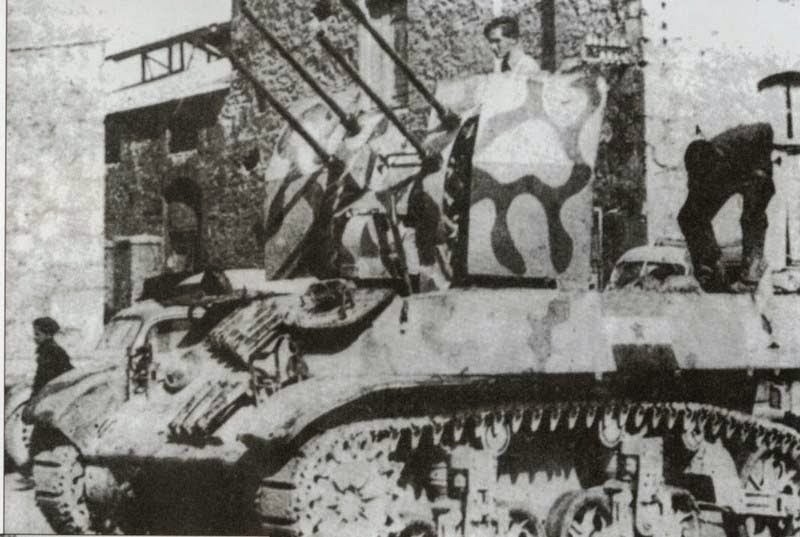Already during the Second World War, the Yugoslav partisan army was equipped with armoured vehicles. Among the usual types where the captured ones from the German and Italian troops and the supplied ones from USA, UK and SSSR. Tanks supplied from the Allies were the M3 Stuart light tanks while the T-34-85 medium tanks were provided from the Soviet side. For more information about that, I recommend the book Tito’s partisans 1941-1945 from Osprey Publishing.
M3 Stuart. When WWII started the Stuart tank was one of the main types within the US Army and was even used by general Patton. As the development of tanks became more dynamic during the war it meant that Stuart became less relevant for engaging with other tanks and instead was used more for reconnaissance missions. However, it preserved its combat role on the Pacific theatre against the Japanese armed forces.
Some of the Yugoslav M3 were modified. In this case, the Stuart was modified into a self-propelled anti-aircraft gun armed with the German Flak 38 quadruple 20 mm AA-gun.
Other were modified into self-propelled anti-tank guns. This example used the German PaK-40 75 mm anti-tank gun. Behind it, the usual M3 can be seen.
For more info about armoured vehicles used by the Yugoslav armed forces during the WWII and the Cold War period, I recommend this page about the armour museum Pivka in Slovenia.
Soviet Union continued to provide Yugoslavia with military equipment after WWII. However, in 1948 all the military cooperation between the countries was closed down because of the diplomatic crisis between Tito and Stalin. For Yugoslavia, the crisis of "Informbureau" meant that the country decided to end the political ties with the Soviet Union and to pursue a neutrality policy. It also meant to be in a new position regarding defence policy where military equipment neither would come from the Western bloc of states or from the Eastern block of states.
According to many tank experts, the T-34 was the best tank during WWII. The tank was mass-produced in big numbers just as for example the American M4 Sherman. The T-34 was delivered to the Yugoslav armed forces between the period of 1944-1948. The photographs above and down below are showing troops during training in tank service, probably from the late 40's or the early 50's.
It is worth to mention that the T-34 was kept in service during the whole Cold War period. This was a part of the Yugoslav concept of "total defence" which meant that even older or obsolete types of weaponry would be used in the case of war. When the break-up of Yugoslavia started the T-34:s' were taken out from the magazines and used in combat. This photography shows a T-34 from the Yugoslav People's army that went off the road and was heavily damaged during fighting in Croatia in 1991.
In connection with the
political developments, an idea to start producing own tanks came
up within the Yugoslav armed forces. Regarding fire-power, protection and
mobility the T-34 was regarded as the most powerful tank. For that reason T-34
came to be an inspiration for the project called Teški Tenk Vozilo. Later
the project tank came to be called A-1. The interesting fact is that ”teški
tenk vozilo” on Serbo-Croatian means "heavy
tank vehicle" since the A-1 did not become a notably heavier
version of the T-34.
The biggest difference between the A-1 and the T-34 was that the A-1 had a different and heavier turret. Among the minor differences were that the Soviet optics TS-15 were replaced with the German TZF and also that the British radio SET-18WF was introduced. The total weight of the A-1 was for two tons heavier comparing to the T-34 and the cannon calibre was the same, the 85 mm gun, even if the cannon of A-1 was of different shape.
The A-1 shown on the streets of Belgrade probably in 1949 or 1950 during the military parade on the 9th May. On the below picture a A-1 with the Browning M1919 can be seen with the slogan : Technique to the army with our strength.
The Yugoslav T-34 was produced in only 5 examples. All of them were moved to the city of Banja Luka in today's Bosnia and Herzegovina where they were used for training at the tank school. The project was a result of broken relationships between Yugoslavia and the Soviet Union at the beginning of the Cold War. However, the project came to be turned down because of the new political development. In the beginning of the 1950s Titos regime started to orientate itself more towards the Western bloc. At the same time, the USA started to deliver military equipment to Yugoslavia.
Soon the Yugoslav armed forces received a new tank of a newer generation. The M47 Patton that used a 90 mm cannon came to replace the T-34 as the most powerful tank. Soon the Yugoslav General Staff concluded that the A-1 project obsolete.
Today the only remaining example of the "heavy tank" project can be seen at the military museum in Belgrade.
The introduction of the M47 Patton and later of the Soviet T-55 tanks meant that the Yugoslav armed forces came to dispose tanks from a new generation compared to ones that were produced during the later stages of the WWII. This photography is probably among the oldest ones showing the M47 in Yugoslav service.
Sources
Yandex.ru
https://fotki.yandex.ru/users/mr-grischin2009/album/210855/
Tito’s partisans 1941-1945 av Vuksic Velimir från Osprey Publishing
Photos are from Flickr and Yandex
























